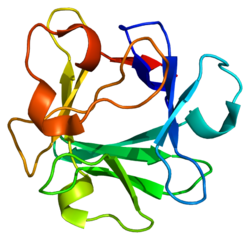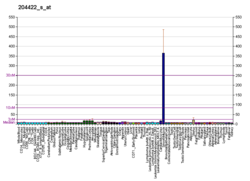塩基性線維芽細胞増殖因子
塩基性線維芽細胞増殖因子(えんきせいせんいがさいぼうぞうしょくいんし、英: basic fibroblast growth factor、略称: bFGF)またはFGF2、FGF-βは、FGF2遺伝子によってコードされる成長因子であり、シグナル伝達タンパク質である[5][6]。主に155アミノ酸のポリペプチドとして合成され、18 kDaのタンパク質となる。代替的開始コドンが存在し、N末端が41、46、55または133アミノ酸だけ伸びた、それぞれ22 kDa(196アミノ酸)、22.5 kDa(201アミノ酸)、24 kDa(210アミノ酸)、34 kDa(288アミノ酸)のタンパク質も産生される[7]。一般的に、18 kDa(155アミノ酸)の低分子量(LMW)型は細胞質に位置し、細胞から分泌されることもある一方で、高分子量(HMW)型は細胞核に送られる[8]。
線維芽細胞増殖因子(FGF)タンパク質は1975年に最初に精製されたが、そのすぐ後に他のグループによって異なる条件でbasic FGF、Heparin-binding growth factor-2、Endothelial cell growth factor-2が単離された。シーケンシングによってこれらは実際には同じFGF2タンパク質であり、FGFタンパク質ファミリーのメンバーであることが明らかにされた[7][9]。FGF2は特異的な線維芽細胞増殖因子受容体(FGFR)タンパク質に結合して効果を発揮する。FGFRも密接に関連したタンパク質ファミリーを構成している。
機能 編集
FGF2は多面的な作用を示す成長因子であり、血管新生に加えて神経系、肺、筋肉、骨、皮膚の発生への関与が示唆されている[10]。
正常な組織では、FGF2は基底膜や血管の内皮下層の細胞外マトリックスに存在している[11][12]。FGF2はシグナルペプチドを持たず、小胞体-ゴルジ体経路を介さない非典型的な経路で細胞膜へ埋め込まれ、細胞外へ分泌されていると考えられている[13]。基底膜に結合したFGF2はタンパク質分解やヘパラン硫酸分解酵素の作用によって解放され、可動性となった成長因子は内皮細胞に作用し、新たな血管の形成を媒介する[10]。
FGF2はヒトの脂肪細胞でも合成されて分泌され、血液試料中のFGF2の濃度はBMIと相関している。脂肪細胞から分泌されたFGF2は前骨芽細胞に作用し、FGFR1へ結合してPI3キナーゼを活性化して増殖を促進する[14]。
FGF2は心臓発作と関係した傷害から心臓を保護し、組織の死を低減させて再灌流後の機能改善を促進することが予備的な動物研究から示されている[15]。
また近年の研究では、FGF2レベルの低下は過度の不安と関係していることが示されている[16]。
FGF2はヒト胚性幹細胞の培地の重要な構成要素である。FGF2は細胞を未分化状態に維持するために必要であるが、その機構はあまり理解されていない。FGF2はグレムリンの発現を誘導し、グレムリンは骨形成タンパク質(BMP)による分化の誘導を阻害することが知られている[17]。FGF2はマウスのフィーダー細胞依存的な培養系でも、フィーダーフリー、無血清の培養系でも必要である[18]。FGF2はBMP4とともに幹細胞から中胚葉系細胞への分化を促進する。分化後、BMP4とFGF2で処理された細胞は未処理細胞と比較して一般的に骨形成性・軟骨形成性分化の量が多くなる[19]。しかしながら、低濃度のFGF2(10 ng/mL)は骨芽細胞の分化に阻害的な影響を与える可能性がある[20]。
相互作用 編集
出典 編集
- ^ a b c GRCh38: Ensembl release 89: ENSG00000138685 - Ensembl, May 2017
- ^ a b c GRCm38: Ensembl release 89: ENSMUSG00000037225 - Ensembl, May 2017
- ^ Human PubMed Reference:
- ^ Mouse PubMed Reference:
- ^ “Cloning and expression of two distinct high-affinity receptors cross-reacting with acidic and basic fibroblast growth factors”. The EMBO Journal 9 (9): 2685–92. (September 1990). doi:10.1002/j.1460-2075.1990.tb07454.x. PMC 551973. PMID 1697263.
- ^ “Assignment1 of the human basic fibroblast growth factor gene FGF2 to chromosome 4 band q26 by radiation hybrid mapping”. Cytogenetics and Cell Genetics 83 (1–2): 73. (1998). doi:10.1159/000015129. PMID 9925931.
- ^ a b “Basic fibroblast growth factor gene expression”. Annals of the New York Academy of Sciences 638 (1): 109–26. (December 1991). doi:10.1111/j.1749-6632.1991.tb49022.x. PMID 1785797.
- ^ “The ins and outs of fibroblast growth factor receptor signalling”. Clinical Science 127 (4): 217–31. (August 2014). doi:10.1042/CS20140100. PMID 24780002.
- ^ “The heparin-binding (fibroblast) growth factor family of proteins”. Annual Review of Biochemistry 58: 575–606. (1989). doi:10.1146/annurev.bi.58.070189.003043. PMID 2549857.
- ^ a b van Wijk, Xander M. R.; van Kuppevelt, Toin H. (2014-07). “Heparan sulfate in angiogenesis: a target for therapy”. Angiogenesis 17 (3): 443–462. doi:10.1007/s10456-013-9401-6. ISSN 1573-7209. PMID 24146040.
- ^ Folkman, J.; Klagsbrun, M.; Sasse, J.; Wadzinski, M.; Ingber, D.; Vlodavsky, I. (1988-02). “A heparin-binding angiogenic protein--basic fibroblast growth factor--is stored within basement membrane”. The American Journal of Pathology 130 (2): 393–400. ISSN 0002-9440. PMC 1880518. PMID 3277442.
- ^ Vlodavsky, I.; Folkman, J.; Sullivan, R.; Fridman, R.; Ishai-Michaeli, R.; Sasse, J.; Klagsbrun, M. (1987-04). “Endothelial cell-derived basic fibroblast growth factor: synthesis and deposition into subendothelial extracellular matrix”. Proceedings of the National Academy of Sciences of the United States of America 84 (8): 2292–2296. doi:10.1073/pnas.84.8.2292. ISSN 0027-8424. PMC 304636. PMID 3470794.
- ^ La Venuta, Giuseppe; Zeitler, Marcel; Steringer, Julia P.; Müller, Hans-Michael; Nickel, Walter (2015-11-06). “The Startling Properties of Fibroblast Growth Factor 2: How to Exit Mammalian Cells without a Signal Peptide at Hand”. The Journal of Biological Chemistry 290 (45): 27015–27020. doi:10.1074/jbc.R115.689257. ISSN 1083-351X. PMC 4646381. PMID 26416892.
- ^ “Adipocyte-secreted factors increase osteoblast proliferation and the OPG/RANKL ratio to influence osteoclast formation”. Molecular and Cellular Endocrinology 349 (2): 180–8. (February 2012). doi:10.1016/j.mce.2011.10.018. PMID 22040599.
- ^ “Cardiac-specific overexpression of fibroblast growth factor-2 protects against myocardial dysfunction and infarction in a murine model of low-flow ischemia”. Circulation 108 (25): 3140–8. (December 2003). doi:10.1161/01.CIR.0000105723.91637.1C. PMID 14656920.
- ^ “A new role for FGF2 as an endogenous inhibitor of anxiety”. The Journal of Neuroscience 29 (19): 6379–87. (May 2009). doi:10.1523/JNEUROSCI.4829-08.2009. PMC 2748795. PMID 19439615.
- ^ Pereira, R. C.; Economides, A. N.; Canalis, E. (2000-12). “Bone morphogenetic proteins induce gremlin, a protein that limits their activity in osteoblasts”. Endocrinology 141 (12): 4558–4563. doi:10.1210/endo.141.12.7851. ISSN 0013-7227. PMID 11108268.
- ^ “A novel chemical-defined medium with bFGF and N2B27 supplements supports undifferentiated growth in human embryonic stem cells”. Biochemical and Biophysical Research Communications 346 (1): 131–9. (July 2006). doi:10.1016/j.bbrc.2006.05.086. PMID 16753134.
- ^ “Enhancement of osteogenic and chondrogenic differentiation of human embryonic stem cells by mesodermal lineage induction with BMP-4 and FGF2 treatment”. Biochemical and Biophysical Research Communications 430 (2): 793–7. (January 2013). doi:10.1016/j.bbrc.2012.11.067. PMID 23206696.
- ^ “Epidermal growth factor enhances osteogenic differentiation of dental pulp stem cells in vitro”. Head & Face Medicine 11: 29. (September 2015). doi:10.1186/s13005-015-0086-5. PMC 4558932. PMID 26334535.
- ^ a b “Regulation of mRNA Export Through API5 and Nuclear FGF2 Interaction”. Nucleic Acids Research 48 (11): 6340–6352. (June 2020). doi:10.1093/nar/gkaa335. PMC 7293033. PMID 32383752.
- ^ “Binding of FGF-1 variants to protein kinase CK2 correlates with mitogenicity”. The EMBO Journal 21 (15): 4058–69. (August 2002). doi:10.1093/emboj/cdf402. PMC 126148. PMID 12145206.
- ^ “Intracellular association of FGF-2 with the ribosomal protein L6/TAXREB107”. Biochemical and Biophysical Research Communications 252 (2): 524–8. (November 1998). doi:10.1006/bbrc.1998.9677. PMID 9826564.
- ^ “Fibroblast growth factor-2 interacts with free ribosomal protein S19”. Biochemical and Biophysical Research Communications 289 (2): 591–6. (November 2001). doi:10.1006/bbrc.2001.5960. PMID 11716516.
関連文献 編集
- “Fibroblast growth factors”. Genome Biology 2 (3): REVIEWS3005. (2001). doi:10.1186/gb-2001-2-3-reviews3005. PMC 138918. PMID 11276432.
- “Angiogenic and lymphangiogenic molecules in hematological malignancies”. Leukemia & Lymphoma 43 (2): 219–24. (February 2002). doi:10.1080/10428190290005964. PMID 11999550.
- “Regulation of human cranial osteoblast phenotype by FGF-2, FGFR-2 and BMP-2 signaling”. Histology and Histopathology 17 (3): 877–85. (2003). doi:10.14670/HH-17.877. PMID 12168799.
- “Propofol increases expression of basic fibroblast growth factor after transient cerebral ischemia in rats”. Neurochemical Research 38 (3): 530–7. (March 2013). doi:10.1007/s11064-012-0945-4. PMC 3574197. PMID 23247820.
- “Basic fibroblast growth factor: an extracellular mechanotransducer in articular cartilage?”. Biochemical Society Transactions 34 (Pt 3): 456–7. (June 2006). doi:10.1042/BST0340456. PMID 16709186.
- “The discovery of basic fibroblast growth factor/fibroblast growth factor-2 and its role in haematological malignancies”. Cytokine & Growth Factor Reviews 18 (3–4): 327–34. (2007). doi:10.1016/j.cytogfr.2007.04.011. PMID 17537668.
- “Reverse transcription with nested polymerase chain reaction shows expression of basic fibroblast growth factor transcripts in human granulosa and cumulus cells from in vitro fertilisation patients”. Biochemical and Biophysical Research Communications 187 (3): 1227–31. (September 1992). doi:10.1016/0006-291X(92)90434-M. PMID 1417798.
- “Three-dimensional structures of acidic and basic fibroblast growth factors”. Science 251 (4989): 90–3. (January 1991). doi:10.1126/science.1702556. PMID 1702556.
- “Three-dimensional structure of human basic fibroblast growth factor”. Proceedings of the National Academy of Sciences of the United States of America 88 (8): 3441–5. (April 1991). doi:10.1073/pnas.88.8.3441. PMC 51463. PMID 1707542.
- “Crystal structure of basic fibroblast growth factor at 1.6 A resolution”. Journal of Biochemistry 110 (3): 360–3. (September 1991). doi:10.1093/oxfordjournals.jbchem.a123586. PMID 1769963.
- “Three-dimensional structure of human basic fibroblast growth factor, a structural homolog of interleukin 1 beta”. Proceedings of the National Academy of Sciences of the United States of America 88 (8): 3446–50. (April 1991). doi:10.1073/pnas.88.8.3446. PMC 51464. PMID 1849658.
- “Characterization and molecular cloning of a putative binding protein for heparin-binding growth factors”. The Journal of Biological Chemistry 266 (25): 16778–85. (September 1991). PMID 1885605.
- “The human basic fibroblast growth factor gene (FGFB) is assigned to chromosome 4q25”. Cytogenetics and Cell Genetics 54 (3–4): 159–60. (1991). doi:10.1159/000132983. PMID 2265560.
- “The human basic fibroblast growth factor gene is located on the long arm of chromosome 4 at bands q26-q27”. Oncogene Research 5 (3): 241–4. (1990). PMID 2320377.
- “Amino-terminal sequence of a large form of basic fibroblast growth factor isolated from human benign prostatic hyperplastic tissue”. Biochemical and Biophysical Research Communications 142 (3): 702–9. (February 1987). doi:10.1016/0006-291X(87)91471-9. PMID 2435284.
- “Cloning and expression of cDNA encoding human basic fibroblast growth factor”. FEBS Letters 213 (1): 189–94. (March 1987). doi:10.1016/0014-5793(87)81489-8. PMID 2435575.
- “High molecular mass forms of basic fibroblast growth factor are initiated by alternative CUG codons”. Proceedings of the National Academy of Sciences of the United States of America 86 (6): 1836–40. (March 1989). doi:10.1073/pnas.86.6.1836. PMC 286799. PMID 2538817.
- “Human basic fibroblast growth factor gene encodes four polypeptides: three initiate translation from non-AUG codons”. Proceedings of the National Academy of Sciences of the United States of America 86 (11): 3978–81. (June 1989). doi:10.1073/pnas.86.11.3978. PMC 287371. PMID 2726761.
- “Human basic fibroblast growth factor: nucleotide sequence, genomic organization, and expression in mammalian cells”. Cold Spring Harbor Symposia on Quantitative Biology 51 Pt 1: 657–68. (1987). doi:10.1101/sqb.1986.051.01.078. PMID 3472745.
- “A form of human basic fibroblast growth factor with an extended amino terminus”. Biochemical and Biophysical Research Communications 144 (2): 543–50. (April 1987). doi:10.1016/S0006-291X(87)80001-3. PMID 3579930.
関連項目 編集
外部リンク 編集
- Basic Fibroblast Growth Factor - MeSH・アメリカ国立医学図書館・生命科学用語シソーラス(英語)
- Human FGF2 genome location and FGF2 gene details page in the UCSC Genome Browser.






